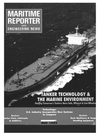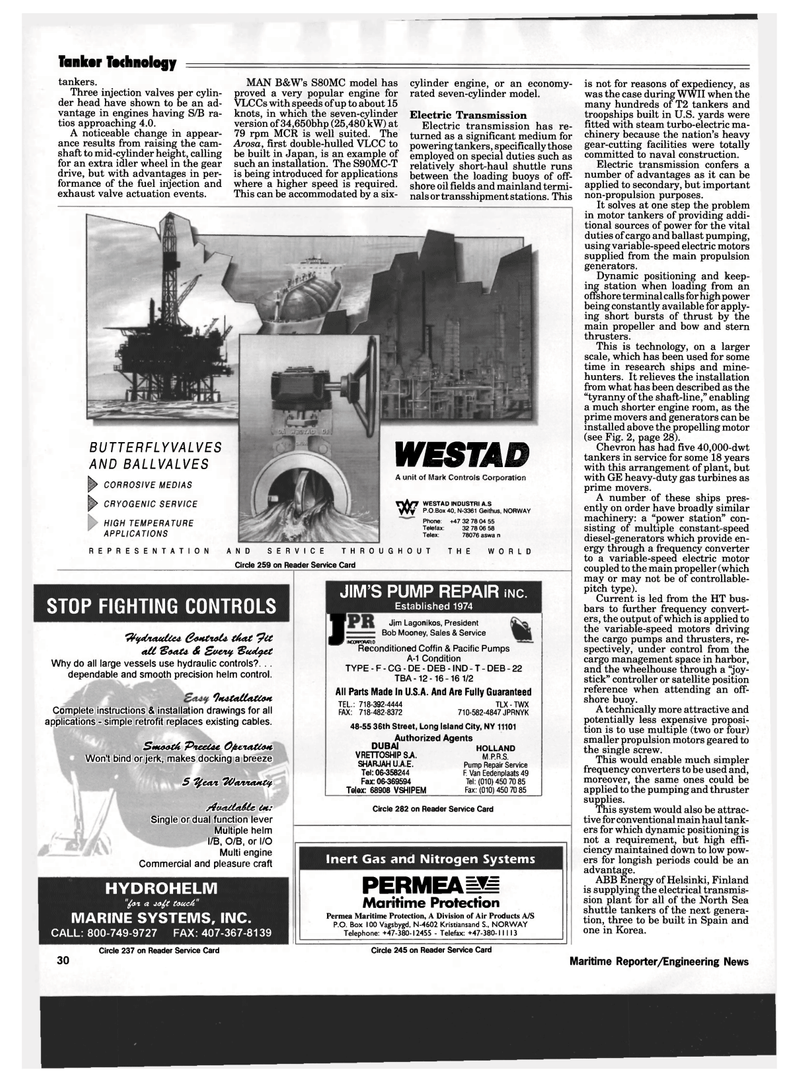
Page 28: of Maritime Reporter Magazine (May 1994)
Read this page in Pdf, Flash or Html5 edition of May 1994 Maritime Reporter Magazine
Tanker Technology = tankers.
Three injection valves per cylin- der head have shown to be an ad- vantage in engines having S/B ra- tios approaching 4.0.
A noticeable change in appear- ance results from raising the cam- shaft to mid-cylinder height, calling for an extra idler wheel in the gear drive, but with advantages in per- formance of the fuel injection and exhaust valve actuation events.
MAN B&W's S80MC model has proved a very popular engine for
VLCCs with speeds of up to about 15 knots, in which the seven-cylinder version of34,650bhp (25,480 kW) at 79 rpm MCR is well suited. The
Arosa, first double-hulled VLCC to be built in Japan, is an example of such an installation. The S90MC-T is being introduced for applications where a higher speed is required.
This can be accommodated by a six- cylinder engine, or an economy- rated seven-cylinder model.
Electric Transmission
Electric transmission has re- turned as a significant medium for powering tankers, specifically those employed on special duties such as relatively short-haul shuttle runs between the loading buoys of off- shore oil fields and mainland termi- nals or transshipment stations. This is not for reasons of expediency, as was the case during WWII when the many hundreds of T2 tankers and troopships built in U.S. yards were fitted with steam turbo-electric ma- chinery because the nation's heavy gear-cutting facilities were totally committed to naval construction.
Electric transmission confers a number of advantages as it can be applied to secondary, but important non-propulsion purposes.
It solves at one step the problem in motor tankers of providing addi- tional sources of power for the vital duties of cargo and ballast pumping, using variable-speed electric motors supplied from the main propulsion generators.
Dynamic positioning and keep- ing station when loading from an offshore terminal calls for high power being constantly available for apply- ing short bursts of thrust by the main propeller and bow and stern thrusters.
This is technology, on a larger scale, which has been used for some time in research ships and mine- hunters. It relieves the installation from what has been described as the "tyranny of the shaft-line," enabling a much shorter engine room, as the prime movers and generators can be installed above the propelling motor (see Fig. 2, page 28).
Chevron has had five 40,000-dwt tankers in service for some 18 years with this arrangement of plant, but with GE heavy-duty gas turbines as prime movers.
A number of these ships pres- ently on order have broadly similar machinery: a "power station" con- sisting of multiple constant-speed diesel-generators which provide en- ergy through a frequency converter to a variable-speed electric motor coupled to the main propeller (which may or may not be of controllable- pitch type).
Current is led from the HT bus- bars to further frequency convert- ers, the output of which is applied to the variable-speed motors driving the cargo pumps and thrusters, re- spectively, under control from the cargo management space in harbor, and the wheelhouse through a "joy- stick" controller or satellite position reference when attending an off- shore buoy.
A technically more attractive and potentially less expensive proposi- tion is to use multiple (two or four) smaller propulsion motors geared to the single screw.
This would enable much simpler frequency converters to be used and, moreover, the same ones could be applied to the pumping and thruster supplies.
This system would also be attrac- tive for conventional main haul tank- ers for which dynamic positioning is not a requirement, but high effi- ciency maintained down to low pow- ers for longish periods could be an advantage.
ABB Energy of Helsinki, Finland is supplying the electrical transmis- sion plant for all of the North Sea shuttle tankers of the next genera- tion, three to be built in Spain and one in Korea.
REPRESENTATION AND SERVICE THROUGHOUT
Circle 259 on Reader Service Card
THE WORLD
STOP FIGHTING CONTROLS ^^RW&M &*Ht>i*U t&zt "pit all & Svwf- "Sccd^et
Why do all large vessels use hydraulic controls?. . . dependable and smooth precision helm control.
It&talleUliHi
Complete instructions & installation drawings for all applications - simple retrofit replaces existing cables.
SmukUA. "Piccd*. Ofu.% Won't bind or jerk, makes docking a breeze
5 "Tfeevi 'TOwuutty
sfwUtalllc it:
Single or dual function lever
Multiple helm
l/B, O/B, or I/O
Multi engine
Commercial and pleasure craft
JIM'S PUMP REPAIR INC.
Established 1974
I Jim Lagonikos, President Bob Mooney, Sales & Service INCOBPOFWH)
Reconditioned Coffin & Pacific Pumps
A-1 Condition
TYPE - F - CG - DE - DEB - IND - T - DEB - 22
TBA-12-16-16 1/2
All Parts Made In U.S.A. And Are Fully Guaranteed
TEL.:
FAX:
718-392-4444
718-482-8372
TLX - TWX
710-582-4847 JPRNYK
48-55 36th Street, Long Island City, NY 11101
Authorized Agents
DUBAI HOLLAND
VRETTOSHIP SA
SHARJAH U.A.E.
Tel: 06-358244
Fax: 06-369594
Telex: 68908 VSHIPEM
M.P.R.S.
Pump Repair Service
F. Van Eedenplaats 49
Tel: (010) 450 70 85
Fax: (010) 450 70 85
Circle 282 on Reader Service Card
Inert Gas and Nitrogen Systems
PERMEAip
Maritime Protection
Permea Maritime Protection, A Division of Air Products A/S
P.O. Box 100 Vagsbygd, N-4602 Kristiansand S„ NORWAY
Telephone: +47-380-124S5 - Telefax: +47-380-11 I 13
WESTAD
A unit of Mark Controls Corporation
T$ff WESTAD INDUSTRI A S
yVv P.O.Box 40, N-3361 Geithus, NORWAY
Phone: +47 32 78 04 55
Telefax: 32 78 06 58
Telex: 78076 aswa n
BUTTERFLYVALVES
AND BALLVALVES
• CORROSIVE MEDIAS
||> CRYOGENIC SERVICE
HIGH TEMPERATURE
APPLICATIONS
...
HYDROHELM
"frxz a jo^t CacccA"
MARINE SYSTEMS, INC.
CALL: 800-749-9727 FAX: 407-367-8139
Circle 237 on Reader Service Card
30
Circle 245 on Reader Service Card
Maritime Reporter/Engineering News

 27
27

 29
29
